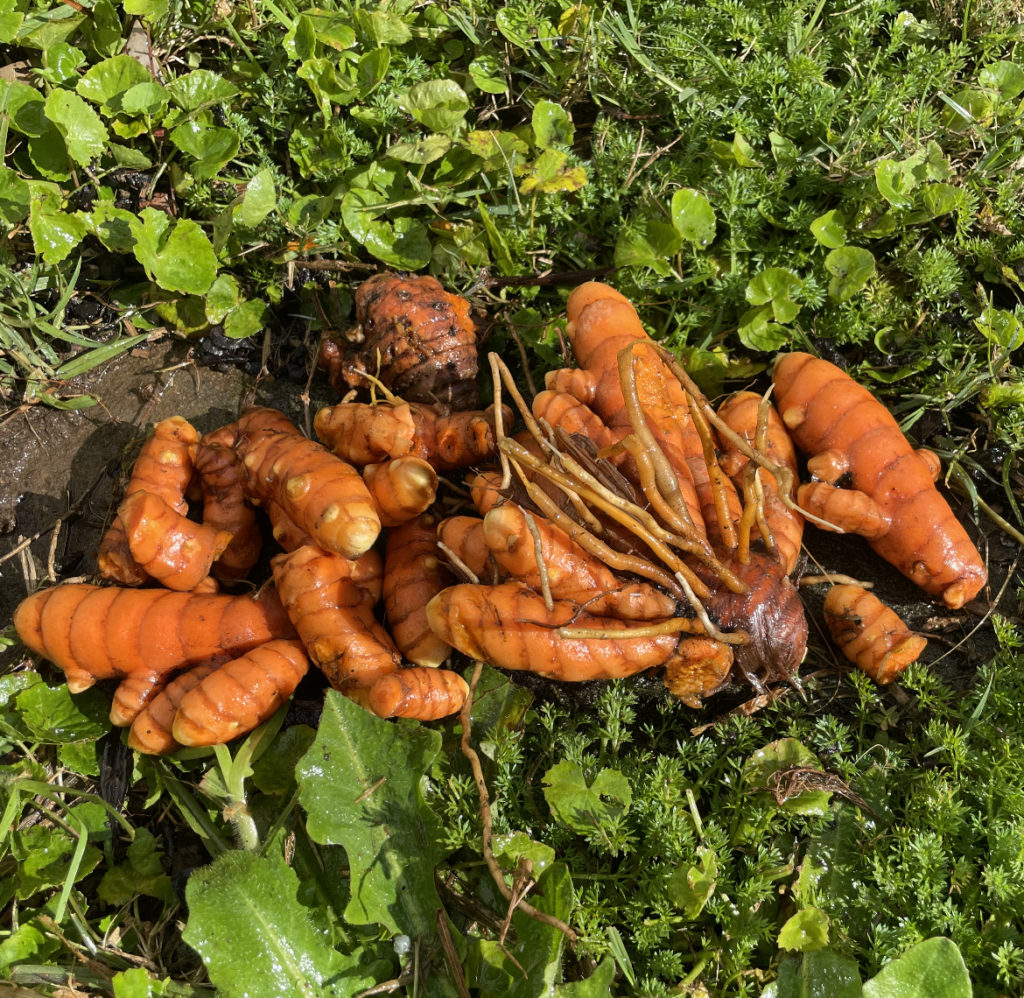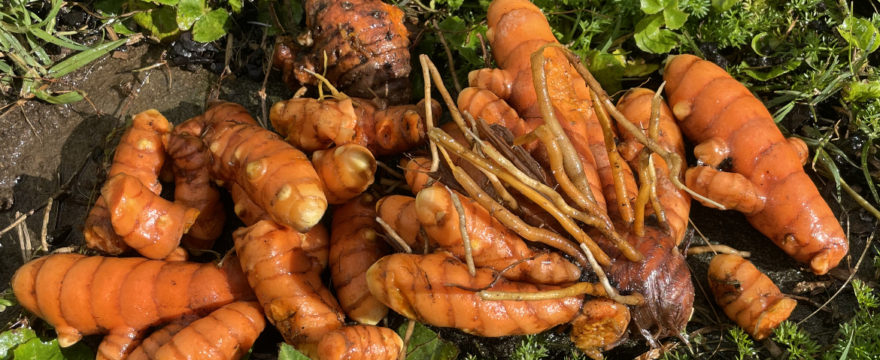
Curcumin is one of my top natural compounds as both an anti-cancer agent and all-round health powdered gold. This is one food I consume every day. It wins my gold star for a variety of reasons. The mechanisms of how it works in humans seem to lend well to potentially suppressing the growth of many cancer types. It is easy to add to your daily menu as an inexpensive, ground powder. I find it easy to grow and rather nice to nibble on the raw tubers. It is considered safe except for people with some specific conditions.
What is it?
Curcumin is a bright yellow chemical produced by plants of the Curcuma longa species. It is the principal curcuminoid of turmeric (Curcuma longa), a member of the ginger family, Zingiberaceae.
Curcumin (diferuloylmethane), the active constituent of turmeric extract is naturally occurring polyphenol (polyphenols are organic compounds, of plant origin, often colourful and to have antioxidant properties) has pharmacologic properties, including anti-inflammatory and antioxidant, antiproliferative and antiangiogenic activities (antiangiogenics can interfere with the fine network of blood vessels needed by tumors to grow and metastasize). For more information on boosting your immune system with polyphenols CLICK HERE.
What can it do?
‘Despite low bioavailability, curcumin has demonstrated tremendous therapeutic efficacy against various chronic diseases, including cancer, cardiovascular diseases, inflammatory diseases, metabolic diseases, neurological diseases, skin diseases, liver diseases.
Ample amount of data obtained from clinical studies suggested that oral or topical curcumin was mostly well-tolerated, and it has shown biological activity in patients with chronic diseases at its general range of bioavailability. Even the lowest level of circulating curcumin at steady-state has been shown to be biologically active’.1
In clinical trials, curcumin treatment protocols (formulation, dose, and duration) vary among studies. However, these trials consistently point out that the compound is well-tolerated and safe. The bioavailability can be enhanced by consuming black pepper or piperine. A clinical trial with healthy human volunteers treated with a combination of curcumin and piperine (piperine is a compound of black pepper) found enhanced bioavailability of curcumin without any adverse effects 2.
Curcumin is well tolerated by individuals ingesting it for possible cancer prevention or in combination with conventional cancer therapies, and it shows low toxicity toward noncancerous cells at low dosages. Curcumin is particularly effective against cancer stem cells, which are treatment-resistant, aggressive, and tumor-initiating3. Antioxidant properties of curcumin may prevent carcinogenesis.
Curcumin Enhances Digestive Microflora
A Review paper entitled ‘Mutual Two-Way Interactions of Curcumin and Gut Microbiota’ by Pluta et al 2020 states;
The new working hypothesis that could explain the curative role of curcumin, despite its limited availability, is that curcumin acts indirectly on the brain, affecting the “gut-brain-microflora axis”, a complex two-way system in which the gut microbiome and its composition, are factors that preserve and determine brain health. It is therefore suspected that curcumin and its metabolites have a direct regulatory effect on gut microflora and vice versa, which may explain the paradox between curcumin’s poor bioavailability and its commonly reported therapeutic effects. Curcumin and its metabolites can have health benefits by eliminating intestinal microflora dysbiosis. In addition, curcumin undergoes enzymatic modifications by bacteria, forming pharmacologically more active metabolites than their parent, curcumin.
Curcumin may act as a promotion of proliferation, growth and/or survival factors for beneficial members of the intestinal microflora.4
For other information relating to the brain and mind CLICK HERE
Who should avoid Curcumin?
Based on available data, the use of curcumin is contraindicated in people with liver disease, such as cirrhosis, gallstones, gallbladder and biliary obstruction, acute gall colic and obstructive jaundice. Alcoholism or simultaneous alcohol consumption is also a contraindication to curcumin. In addition, curcumin is not recommended for people taking blood thinners, reserpine or nonsteroidal anti-inflammatory drugs, as it may interact with these drugs.4 High-dose curcumin should be used cautiously in patients with subclinical iron deficiency, chronic anemia and consumptive anemia caused by excessive loads of malignant tumors, although the antitumor effects may be boosted by curcumin-induced iron failure5. People undergoing chemotherapy treatment should avoid consuming curcumin as studies suggest it can interfere with chemotherapy agents.
For more information on staying safe CLICK HERE.
Dosage
The Joint FAO/WHO Committee of Experts on Food Additives (JECFA) and the European Union Food Science Committee (SCF) have developed a recommended daily intake of 0–3 mg/kg curcumin.
In animal and clinical studies, toxicological evaluation has shown that curcumin is considered a pharmacologically safe substance at a dose of up to 12 g per day 6.
An intervention with curcumin in advanced colon cancer showed that administration of up to 3600 mg daily for four months was well tolerated as a whole, with diarrhea and nausea in some cases, although these side effects were relieved by themselves 7.
One study 8 demonstrated that curcumin is not toxic to humans up to 8,000 mg/day when taken by mouth for 3 months. However, 1500 mg/d is considered a high dose.
Cooking with Curcumin
For a delicious and easy-to-cook, Garlic and Spanish Omelette recipe
For more about targeting cancer with food, CLICK HERE
Supporting Research Studies
1. Kunnumakkara AB, Harsha C, Banik K, et al. Is curcumin bioavailability a problem in humans: lessons from clinical trials. Expert Opin Drug Metab Toxicol. 2019;15(9):705-733.
2. Shoba G, Joy D, Joseph T, Majeed M, Rajendran R, Srinivas PS. Influence of piperine on the pharmacokinetics of curcumin in animals and human volunteers. Planta Med. 1998;64(4):353-356.
3. De A, Beligala DH, Birkholz TM, Geusz ME. Anticancer Properties of Curcumin and Interactions With the Circadian Timing System. Integr Cancer Ther. 2019;18:1534735419889154.
4. Pluta R, Januszewski S, Ułamek-Kozioł M. Mutual Two-Way Interactions of Curcumin and Gut Microbiota. Int J Mol Sci. 2020;21(3).
5. Liu S, Liu J, He L, et al. A Comprehensive Review on the Benefits and Problems of Curcumin with Respect to Human Health. Molecules. 2022;27(14).
6. Pluta R, Ułamek-Kozioł M, Januszewski S, Czuczwar S. Amyloid pathology in the brain after ischemia. Folia Neuropathol. 2019;57(3):220-226.
7. Hv S, J VT, Hs V, K S. An open label, single arm, prospective clinical study to evaluate liver safety and tolerability of PUREMERIC™ (standardized extract from Curcuma longa) in healthy subjects. Toxicol Rep. 2021;8:1955-1959.
8. Cheng AL, Hsu CH, Lin JK, et al. Phase I clinical trial of curcumin, a chemopreventive agent, in patients with high-risk or pre-malignant lesions. Anticancer Res. 2001;21(4b):2895-2900.
Other Resources
You may also be interested in my:
- Podcast Interview with Dr Ralph Moss
- Website information on how to target cancer with compounds, diet, mind, and exercise
- Subscription offer, to you so you can receive my latest information and posts to your email
- Review paper published in Integrative Cancer Therapies about Suppression-centric anticancer strategy using Triple negative breast cancer as representative cancer type
- Information on my website about Melanoma and Triple negative breast cancer
PODCAST INTERVIEW
You can now listen to Dr Ralph Moss and I talk about my anticancer strategy and how I came up with the concept.
This aims to potentially combat cancer by suppressing biochemical pathways. This is complementary to traditional cancer treatments using primarily pre-clinical evidence such as in vitro, in vivo and relevant human studies. To listen CLICK HERE
WEBSITE INFORMATION
You can find more information on how to target cancer with natural compounds, diet, mind, and exercise at my website: CLICK HERE
SUBSCRIPTION OFFER
You may like to take up my subscription offer to you. You will receive my latest information and posts on targeting cancer, direct to your email. To take up my offer CLICK HERE.
PAPER
The Suppression-centric anticancer strategy is explained in our medical publication.
A Review of Natural Therapies Potentially Relevant in Triple Negative Breast Cancer Aimed at Targeting Cancer Cell Vulnerabilities
Myfanwy Jane Webb, BScHons, PhD1 and Craig Kukard, MBChB, MMed, FRACP1
For free access to our medical publication CLICK HERE
This is a review paper published in Integrative Cancer Therapies and is about the Suppression-centric anticancer strategy using Triple negative breast cancer as a representative cancer type. It is currently the most downloaded publication for this peer reviewed cancer journal at over 4000 times. The journal has a 5-year impact factor of 3.5.

